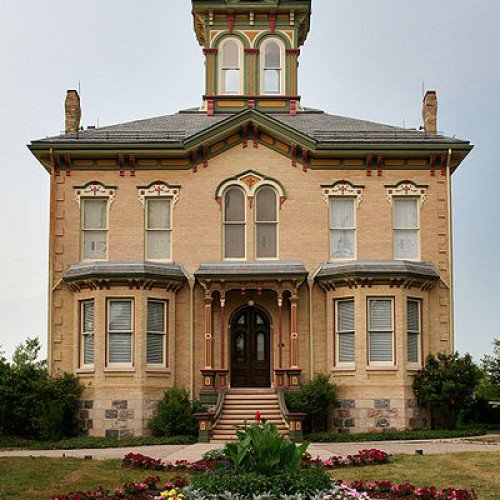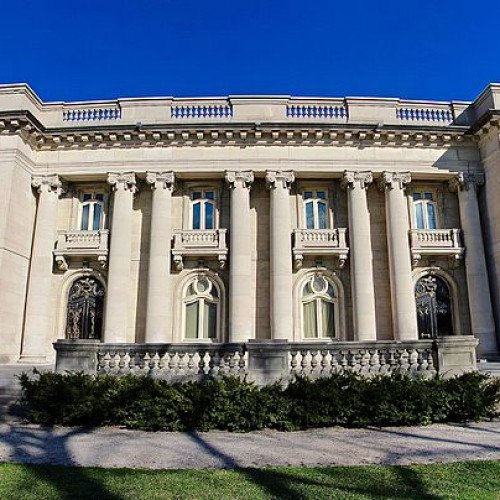Castles of "Canada" CASTLE KILBRIDE vs CHÂTEAU DUFRESNE

CASTLE KILBRIDE
Castle Kilbride is the former residence of James Livingston, a Canadian member of parliament, and owner of flax and linseed oil mills. It was designated a National Historic Site of Canada in March 1994. It was built in Baden, Ontario in 1877 and named after Livingston's birthplace in Scotland. The major feature of Castle Kilbride is the interior decorative murals in the style of the Italian Renaissance. The trompe-l'œil technique used in the murals gives the illusion of a third dimension. The building is also an outstanding example of an Italianate villa of its place and time, and at the time of its building was a tribute to the reputation of its owner as the so-called 'Flax and Oil King of Canada'. The original owner of Castle Kilbride was James Livingston. He was born in East Kilbride, Scotland November 28, 1838. James Livingston moved to Canada from Scotland around the age of 16. When he arrived in Canada he hardly had a penny to his name. He ended up staying in the town of Baden. He started working with his older brother John to earn simple wages to keep themselves. After a while the brothers pooled enough money to start a small flax farm. In 1861, James Livingston married Louise Liersch. To make the processing of flax cheaper the brothers built a flax mill in 1863 and in 1864. Over the course of a little more than ten years James and John got about fifty five tons of flax seeds. He chose a good crop to grow due to the fact that at 1871 there was a call for different linens than cotton. This was due to the civil war in America causes massive devastation to cotton farms. The reason that James Livingston was able to build Castle Kilbride was due to one of the ways that flax seeds can be used for. Flax seeds can be used in hemp for clothing and in linseed oil. Castle Kilbride was built due to the selling of linseed oil. The second mill that was built in Baden during the 1874 year was used to produce linseed oil. When the production of oil paints included linseed oil to add to its quality the Livingston brothers made the 'J&J Livingston Linseed Oil Company'. By 1881 the Livingston brothers had more than 3000 acres that were being used for flax farming. James Livingston built Castle Kilbride. The house was built in 1877, which is also the year that James Livingston was elected Reeve of the Township of Wilmot. James's older brother died in 1896 making him the head of the entire business. Mr. Livingston often looked into innovations of technology, such as the automobile. Eventually the operation of the Baden Linseed oil mill went to his son, John Peter. Every year after James Livingston's retirement there was a picnic held for all of the company employees along with their families. Upon the death of Livingston, their son, John Peter, his wife Laura, and their daughter Laura Louise moved into Castle Kilbride. John Peter continued to meet the approval of the employees as a good man. The Livingston oil company began to decline at the invention of latex paint. Castle Kilbride was not sold to the Township of Wilmot until 1993.
Statistics for this Xoptio

CHÂTEAU DUFRESNE
The Château Dufresne (also known as the Dufresne House) is a historic building in the borough of Mercier–Hochelaga-Maisonneuve in Montreal, Quebec, Canada. It currently functions as a historic house museum. Built from 1915 to 1918, the mansion was designed by Marius Dufresne and the Parisian architect Jules Renard in the Beaux-Arts style. The architects based their plans on the Petit Trianon on the grounds of the Palace of Versailles in France. The building has forty rooms covering about 20,000 square feet. The interior was decorated with a series of murals and ceiling paintings by Guido Nincheri in the 1920s and 1930s. Known for his piety and devout religious leanings, the secular subject matter of the Château Dufresne's interior decor is an exception to the rest of Nincheri's artistic career. Alfred Faniel, a Belgian-born artist, also decorated the house during the same period. The mansion was built as the residence of Marius Dufresne and Oscar Dufresne, two wealthy French Canadian entrepreneurs who played a major role in the history of the city of Maisonneuve (now part of Montreal). The Château Dufresne was originally divided into two separate households, one for each brother. In 1948, the Dufresne family sold the property to the Congregation of the Holy Cross, which used it as a pavilion annex of the Holy Cross College. In 1957, the City of Montreal became the new owner of the estate. The Holy Cross College, however, remained as tenant until 1961. The mansion then housed the Montreal Museum of Contemporary Art from 1965 to 1968, and the Montreal Museum of Decorative Arts from 1976 to 1997. The Château Dufresne was declared a historic monument by the Quebec government in 1976. Beginning in 1999, the building has housed the Château Dufresne Museum, which was renamed the Dufresne-Nincheri Museum in 2014.